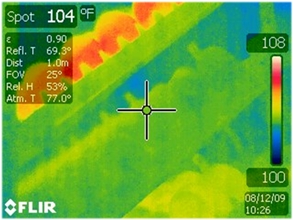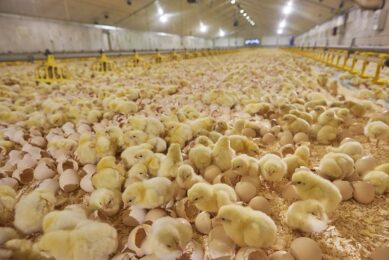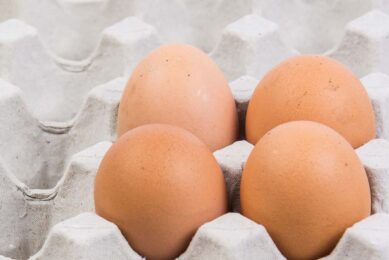Incubation distress easily leads to splayed legs

On some occasions the incidence of splayed or twisted legs in chicken and turkey flocks increases. These issues can be linked to incubator and especially hatcher temperature and ventilation conditions. Management in the hatchery or during transportation to the farm, may also play a role.
Poults and chickens exposed to elevated incubation temperatures may have lower muscular strength to stand up at hatch because they have lower glycogen reserves in the muscles and their myofibers are also thinner. Elevated incubation temperatures accelerate embryo growth to rates that demand higher oxygen consumption than can passively diffuse through the pores of the eggshell. Consequently, the embryo shifts energy metabolism from utilising lipids of the yolk, which requires oxygen, to using limited amounts of glycogen the embryo stored in muscles. Glycogen catabolism does not require oxygen, but produces lactic acid. When acidity increases important contractile and metabolic functions of muscles are hindered. In the case that acidity is not regulated, the accumulation of lactic acid may be a factor in muscular fatigue. Sometimes, this effect can be severe and cause late embryo mortality, but frequently the overheated poults or chickens that hatch will be lethargic, may appear exhausted, slow to search for feed and water, and potentially become the starve outs at the farm increasing the first week mortality.
Tendon development
We have also observed that incubation conditions have a major impact on tendon development. The strength of tendons is crucial for adequate locomotion in all avian species, but especially in turkeys. The structural integrity and mechanical function of tendons depend on precise alignment of Type I collagen fibres during embryonic growth. Typically collagen fibres become thicker with age and exercise. Tendons also contain several proteoglycans and among them, decorin which is an important regulator of matrix assembly, by limiting collagen fibril formation and directing tendon remodeling due to tensile forces. Our research group evaluated the Type I procollagen and decorin with immunohistochemistry in the gastrocnemius tendons of chickens that were incubated either under standard eggshell temperature (37.6ºC) conditions or with an abnormal temperature profile with low eggshell temperature (36ºC) during the first seven days and high eggshell temperatures (39ºC) during the last seven days. The collagen fibres were thinner in the chickens from the abnormal profile during incubation, at hatching, 4, 14 and 21 days of age.
Bone development
Bone development in poultry species can be affected by incubation conditions. The formation of bone collagen matrix starts during the first days of incubation. Researchers have shown that poultry bones initiate ossification processes such as collagen Type X expression, alkaline phosphatase presence, and expression of metalloproteinases at 18 days of incubation in turkey embryos and at 16 days in broilers. In another report, ossification of long bones in turkeys starts at 12 days of embryonic development and increases the rate after 20 days of incubation one week prior to hatch. Several factors that control endochondral ossification of long bones can be affected by incubation conditions, primarily during the plateau stage of oxygen consumption, 3 to 4 days prior to hatching, when bones have their fastest elongation rate. However, bone developmental problems can be caused by suboptimal incubation conditions at any stage of embryo growth.
Chondrocyte proliferation and differentiation are affected by temperature stress during incubation. Suboptimal conditions in the incubator can influence incidence of tibial dyschondroplasia or change dimensions of long bones post-hatch. Many times there have been observed changes in the alignment of the distal tibial and deformation of condiles that cause twisted legs, but which early in life appear very similar to the splayed leg condition. Incubation temperature also has significant impact on the thyroid-IGF1-GH hormonal axis that controls growth plate chondrocyte differentiation, and in general bone development. Additionally, the lipids, trace minerals and vitamins in the yolk are involved in bone modeling and remodeling. If the yolk is not absorbed during this period, bones will not receive nutrients critical for their early development.
Incubational stress
Another factor that can cause the splayed legs is the asymmetry between the left and right limbs due to incubational stress. In all our experiments, we have observed that pre-hatch incubational stress increases relative asymmetry of certain bone parameters in turkeys and chickens. Relative asymmetry between limbs and other bilateral phenotypic traits reflect the ability of hatchlings to cope with stressful conditions during ontogeny. Higher asymmetry of bone traits has also been linked to locomotion problems and worsening of gait scores. Relative asymmetry has been considered a possible parameter to evaluate animal welfare although there has been some controversy about the adequacy of this parameter for welfare in adult poultry. Many other factors can affect relative asymmetry post hatch, but it seems to be an accurate measurement of poultry welfare for embryo development.
Differences among genetic lines?
Frequently it is mentioned that there are differences among genetic lines on the prevalence of leg problems or incidence of splayed legs. We evaluated three temperature incubation profiles on three genetic parent female lines of turkeys where a female grandparent line was crossed with three different grandparent male lines. In this way, egg traits were similar, but embryo genetics were different. The three temperature profiles included elevated, normal, and reduced temperature profiles. Our results indicated no significant effects of incubation by strain interaction on bone development, gait scores or valgus/varus angular deformities; however, incubation profiles affected all these bone and leg health parameters, indicating that independently of strain, incubation may have a stronger effect on leg health. The elevated incubation profile caused a high incidence of splayed legs at hatching independently of the strain. Almost 20% of the hatchlings in the elevated incubation profile were affected. Some of the effects of overheating embryos can be observed at hatching as splayed legs. But overheating may also affect endocrine systems, nutrient utilisation, body formation and the overall health of chicken and turkey flocks. Then, splayed legs can be an indicator that overheating is occurring and corrections need to be made in the machines or in the hatchery management.
MORE INFORMATION |
Join 31,000+ subscribers
Subscribe to our newsletter to stay updated about all the need-to-know content in the poultry sector, three times a week. Beheer
Beheer








 WP Admin
WP Admin  Bewerk bericht
Bewerk bericht